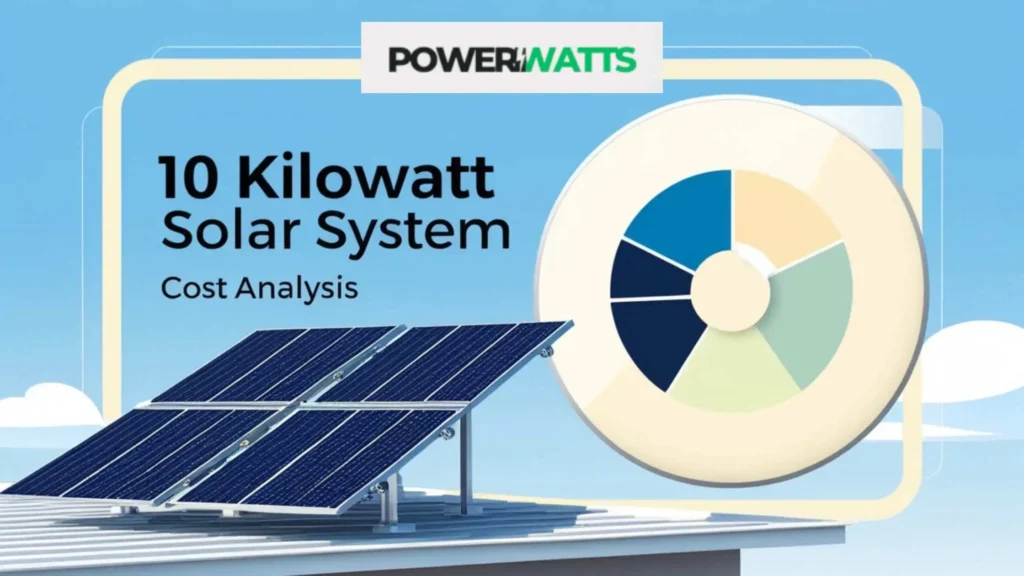As the need for renewable energy grows, more households and companies are exploring solar power as a feasible alternative. A 10 kilowatt (kW) solar system is especially tempting because of its ability to produce significant power, making it ideal for medium to large residential buildings and small business organizations. This article will go over the 10-kilowatt solar system cost, as well as the applications, advantages, and variables that influence the installation process.
Understanding the Basics of a 10 Kilowatt Solar System
A 10 kW solar system is made up of high-efficiency panels that turn sunlight into power. It may generate between 1,100 and 1,200 kilowatt-hours (kWh) per month, depending on location and solar exposure. This capacity is often adequate to power a medium-sized house or small company.
- Solar panels are a key component of a solar system. The key component for capturing sunlight.
- The inverter converts the DC power produced by the panels into the AC electricity utilized in dwellings.
- Mounting Equipment: Attaches panels to roofs or ground mounts.
- Battery Storage (Optional) Excess energy is stored for later use when the weather is not sunny.
Factors Affecting Solar System Costs
Many elements might affect the ultimate cost of constructing a 10 kW solar system:
- Location: Solar installation costs vary by state owing to changes in labor rates, permit fees, and municipal incentives.
- Type of Equipment: Higher-quality panels and inverters may be more expensive but provide greater efficiency and warranties. Installation might be complex.
- Rooftop installations may cost extra if the roof has to be repaired or reinforced.
- Incentives and rebates: Federal and state incentives may greatly lower initial expenses. The federal solar tax credit enables homeowners to deduct 26% of the installation costs from their federal taxes.
Applications of a 10 kW Solar System
A 10 kW solar system is flexible and may be used in many applications:
Residential Use
A 10 kW system may provide the majority, if not all, of an ordinary household’s energy demands, which are around 1,200 kWh per month. It can power vital equipment, including several air conditioning units.
- Refrigerators
- Washing machines
- Lighting systems
Commercial Use
Small companies with significant energy consumption might profit from a 10 kW system by lowering their operating expenses linked with power bills. It can efficiently power office equipment, lights, and other electrical devices.
Off-Grid Applications
When combined with battery storage systems, a 10 kW off-grid solar system may offer dependable energy for houses in distant places that do not have grid power.
Average Cost of a 10 Kilowatt Solar System
The cost of a 10 kW solar system varies greatly depending on numerous variables. Homeowners should anticipate spending between $25,000 and $35,000 before tax credits or incentives are applied.
Cost breakdown
- Solar panels cost about $15,000 to $20,000.
- Inverter: $1,500-$3,000.
- Installation labor typically costs $5,000 to $10,000.
- Permitting and Inspection Fees: An additional $1,000 to $2,000.
Benefits of Installing a 10-Kilowatt Solar System
Investing in a 10 kW solar system has various benefits:
Significant cost savings
By producing your own power, you may significantly cut or even eliminate your monthly utility payments. Homeowners generally save $1,000 to $2,500 per year, depending on their energy use.
Increase in Property Value
Solar systems are desirable features for prospective homeowners. According to studies, properties with solar systems sell for more than those without, with property values rising by up to 4% on average.
Environmental Impact
Switching to solar energy can considerably lower your carbon impact. A typical 10 kW system may save around 184 tons of CO2 emissions throughout its lifespan.
Energy Independence
A solar system gives you more control over your energy generation and use. This independence safeguards you from growing electricity costs and energy shortages.
Financing Options For Solar Systems
Investing in a 10 kW solar system might be difficult owing to the upfront expenditures. However, there are a few funding solutions available:
- Cash Purchase: Paying upfront gives you complete ownership of the system and optimizes long-term savings.
- Solar loans: Many financial organizations provide reasonable interest rates on loans for solar systems.
- Leases and Power Purchase Agreements (PPAs) enable homeowners to install solar systems with little upfront costs by paying monthly fees instead.
Maintenance Requirements for Solar Systems
While solar systems need less maintenance than conventional energy sources, regular upkeep is important for maximum performance.
Cleaning Panels
Dust and dirt may collect on panels over time. Regular cleaning maximizes solar absorption.
Monitoring Performance
Using monitoring systems allows you to measure energy production and spot problems quickly.
Professional Inspections
Periodic inspections by skilled personnel may assist preserve system performance and identify any issues early on.
Conclusion
Investing in a 10 kW solar system offers the possibility to save significantly on energy bills while also contributing to environmental sustainability. Understanding the related costs, which range from installation fees to equipment charges, as well as any incentives, will help you make more educated investment selections. If you’re thinking about adopting solar or want more specialized information on prices particular to your circumstance, get a quote now!
By adopting solar energy today, you not only profit financially but also play an important part in supporting sustainable habits for future generations. The switch to renewable energy is more than simply an investment in your home; it is an investment in our planet’s future.


